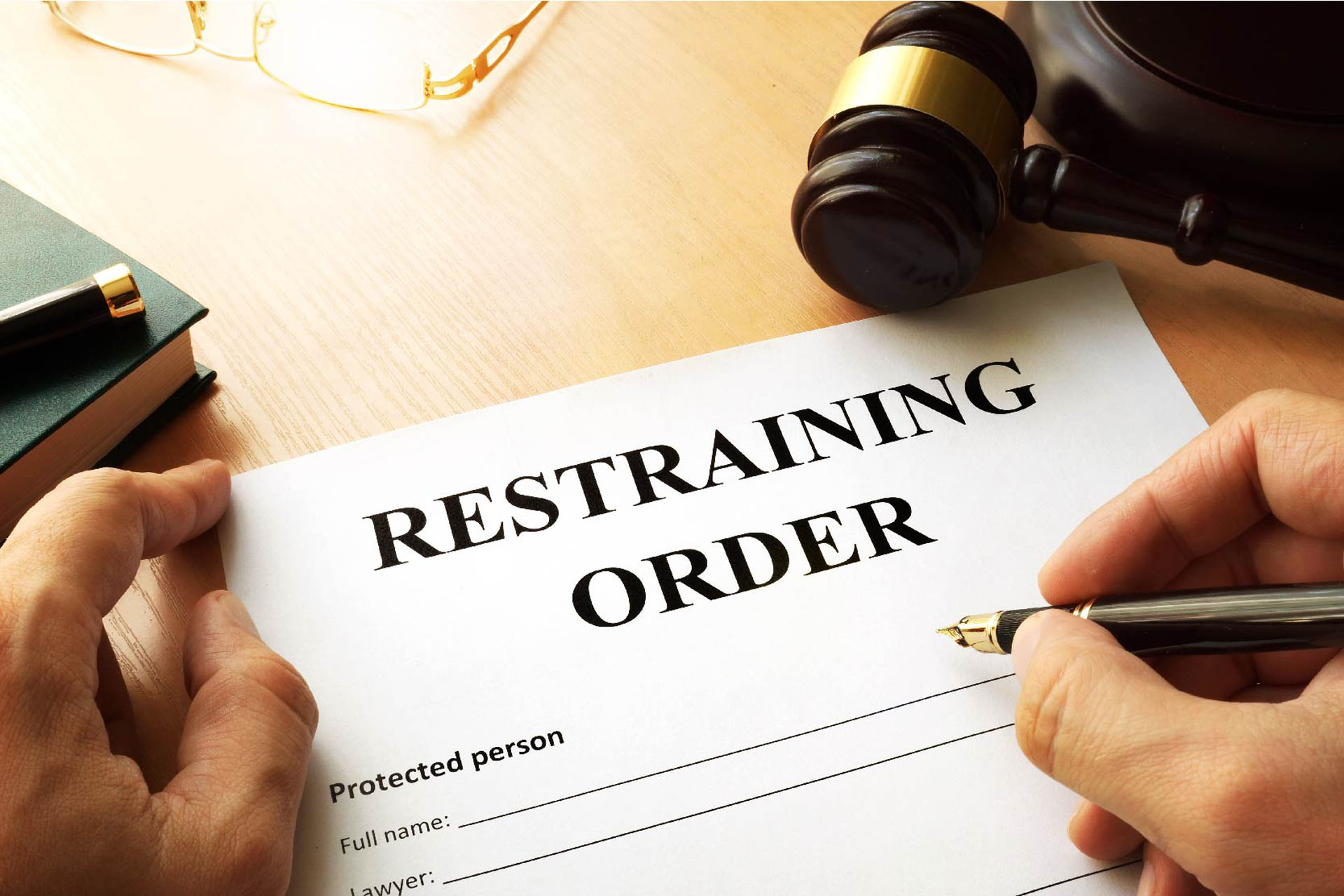Concerned about “does a restraining order go on your record?” The answer is yes; in most jurisdictions, including California, restraining orders do go on your record. However, the visibility and impact of these orders can differ based on whether they are temporary or permanent. However, its impact on your record and any background checks can vary depending on the jurisdiction and the type of order involved:
- Temporary restraining orders may not show up on your record, but final restraining orders can be entered into a domestic violence database and may appear on a background check.
- If a restraining order is not violated and is allowed to expire, it may be eligible for expungement (deletion) from your record.
The specific implications of a restraining order on your record also depend on the jurisdiction and the nature of the order.
This article demystifies the types of restraining orders, how much and how long they can affect you, and outlines legal nuances that could influence their impact on your record.
Key Points
- Restraining orders, both temporary and permanent, create a civil record that carry significant personal consequences, potentially affecting residence, employment, and familial contact, and may lead to a criminal record if violated.
- While temporary restraining orders may not appear on most public background checks and last for a limited time, permanent restraining orders have a lasting impact on an individual’s record, are more visible, and carry more severe consequences for violations.
- The process of removing or expunging a restraining order varies by state and can be complex, requiring legal proceedings and sometimes depending on evidence of fraud or alteration in circumstances, but successful expungement can have a positive effect on future background checks and opportunities.
Restraining Orders and Their Impact on Your Record

Temporary and permanent restraining orders undeniably impact an individual’s record. They can affect personal matters such as residence, employment opportunities, and contact with children. While restraining orders themselves do not appear on a criminal record, they create a separate civil record that can lead to a criminal record if violated. It’s like a domino effect—one thing leads to another, and before you know it, your life is significantly altered.
Not all states handle the impact of restraining orders in the same way. For example, individual’s records in California and Wisconsin do reflect restraining orders. This visibility in the record can be a double-edged sword. On one side, it serves as a deterrent for potential violators. On the other, it can lead to further complications in the lives of those with a restraining order against them.
Temporary vs. Permanent Restraining Orders
Restraining orders range from temporary to permanent, each with its own set of consequences. A temporary restraining order, often issued swiftly to immediately address imminent threats, usually lasts up to 25 days or until a court hearing, whichever occurs first. These orders are primarily visible to law enforcement officials and typically do not surface during most public background checks available to employers.
However, the scenario changes with permanent restraining orders, which can last up to four years. The impact of a permanent restraining order on an individual’s record is more significant, and any violation of the order may lead to criminal charges, potentially resulting in a criminal record. So, while temporary restraining orders are like a warning shot, permanent ones are a full-blown alarm that can significantly affect the person’s life and opportunities.
Consequences of Having a Restraining Order on Your Record
Having a restraining order on your record carries extensive implications. Such an order can restraining order affect personal matters such as your place of residence, employment opportunities, and even contact with your children. These implications can be drastic, turning your life upside down in a matter of moments.
It’s like walking on thin ice—you never know when it might crack. Violating a restraining order can lead to criminal charges, which then appear on your criminal record. This can further complicate matters, affecting your potential for securing:
- employment
- housing
- loans
- professional licenses
- child custody arrangements
It’s a chain reaction that starts with a single restraining order and can spiral into a cascade of challenges.
Legal Definitions and Types of Restraining Orders

Restraining orders play a vital role in protecting individuals from harassment, threats, violence and other forms of abuse. Courts can issue these orders against individuals who qualify as family or household members to prevent abuse. However, the interpretation of ‘abuse’ is subjective and depends on factors like prior history, family dynamics, and witness credibility. It’s a complex issue with no one-size-fits-all solution.
There are various types of restraining orders, each designed to address specific situations. Some common types of restraining orders include:
- 209A Abuse Prevention Order: designed to prevent physical or sexual harm from a family or household member
- No-contact order: prohibits communication with the protected person following a criminal charge
- Workplace violence restraining order: protects employees from violence or threats of violence at work
- Elder or dependent adult abuse restraining order: protects elderly or dependent adults from abuse or neglect
- Civil harassment restraining order: protects individuals from harassment, stalking, or threats of violence
Understanding these nuances is crucial for anyone navigating this complex legal landscape.
Domestic Violence Restraining Orders (DVRO)
Among the types of restraining orders, domestic violence restraining orders carry profound implications. They provide long-term protection from all forms of contact, which may include prohibitions on the offender from certain actions such as remaining in a family home or retaining child custody. These orders serve as a protective barrier, shielding the victim from potential harm.
However, obtaining a permanent protection order is not a simple process. The petitioner must demonstrate with evidence that there is a continued risk of abuse or threats from the individual against whom the order is sought. Anyone who is currently or has previously been a member of the offender’s household can file a domestic violence restraining order. Therefore, it’s not just the issuance but the maintenance of such an order that requires substantial evidence and legal prowess.
Harassment and Stalking Restraining Orders
Another type of restraining order focuses on harassment and stalking. Harassment restraining orders respond to a range of behaviors including threats, intimidation, repeated calls, or unwanted messages. Stalking restraining orders address patterns of behavior that cause fear for safety, such as following, spying, or sending unrequested communications that lead to emotional distress and fear of harm.
Harassment and stalking restraining orders are both legal instruments designed to protect individuals from unwanted and harmful behaviors by another person. They serve as a means to ensure personal safety and peace of mind.
Harassment Restraining Orders
A harassment restraining order is a court-issued order that aims to protect individuals from repeated acts of harassment or intimidation. To obtain this type of order, the victim must file a petition with the court, detailing the nature of the harassment and providing evidence such as messages, emails, or witness testimonies.
Key Features:
- Definition: Protects against unwanted behaviors that cause significant distress but may not involve physical harm.
- Filing Process: Victims must provide evidence of harassment to the court, which will evaluate the claims before issuing a temporary order.
- Duration: Temporary orders can last up to 14 days until a hearing is held; if granted permanently, they can last up to four years, with potential extensions in severe cases.
- Scope: Prohibits the harasser from contacting the victim directly or indirectly and may include provisions for staying away from the victim’s residence or workplace.
Stalking Restraining Orders
While stalking restraining orders are less frequently discussed than harassment orders, they specifically address situations where an individual feels threatened due to another person’s stalking behavior. Stalking is generally defined as a pattern of behavior that causes fear or distress, including following someone, making threats, or engaging in unwanted communication.Key Features:
- Definition: Targets behaviors that involve repeated and unwanted attention that instills fear in the victim.
- Filing Process: Similar to harassment orders, victims must demonstrate evidence of stalking behavior to obtain this order.
- Duration and Enforcement: These orders can also be temporary or permanent, with strict penalties for violations that may include arrest and criminal charges.
Differences Between Harassment and Stalking Restraining Orders
While both types of restraining orders aim to protect individuals from harmful behaviors, there are distinct differences:
| Feature | Harassment Restraining Order | Stalking Restraining Order |
|---|---|---|
| Nature of Behavior | Addresses general harassment and intimidation | Specifically targets stalking behavior |
| Relationship Requirement | Can be filed against acquaintances or strangers | Typically involves a more direct threat from a stalker |
| Evidence Required | Lower threshold; evidence of distress suffices | Requires proof of repeated unwanted behavior causing fear |
| Scope of Protection | Prohibits contact and harassment | Prohibits stalking behaviors and may include additional protections |
How Restraining Orders Appear on Background Checks

Orders of protection, often referred to as restraining orders, can indeed show up on background checks, but the specifics depend on various factors including the type of check being performed.
- Visibility on Background Checks:
- Civil Nature: Orders of protection are civil orders rather than criminal convictions. Generally, they might not appear on standard criminal background checks, which typically focus on criminal convictions and pending charges. However, they are part of public records and can be accessed through civil court record searches.
- Employment and Leasing Checks: Many employers and landlords conduct more thorough background checks that may include civil records. In these cases, an order of protection can be visible and may negatively impact employment opportunities or housing applications.
- Types of Background Checks:
- Standard Criminal Background Check: Typically does not include civil restraining orders unless they are linked to criminal charges.
- In-Depth Checks: More comprehensive checks, such as those for military service or security clearances, will likely reveal any active or expired orders of protection.
- Law Enforcement Checks: Orders of protection will appear in law enforcement databases, meaning that if you are stopped by police, they will see any active orders against you.
- Impact on Life:
- Having an order of protection can lead to significant challenges in various aspects of life, including difficulties in securing housing, obtaining loans, or gaining employment. This is primarily due to the negative implications associated with such orders, which often involve allegations of threats or violence.
In summary, while standard criminal background checks might not reveal orders of protection due to their civil nature, they can still appear in more thorough checks conducted by employers or landlords. It is crucial for individuals with such orders to understand their potential impact on future opportunities and consider seeking legal advice for expungement options if applicable.
Public Record Status
A restraining order’s status as a public record can considerably influence its visibility on background checks. Restraining orders are public records that can be requested from the court clerk or accessed online through electronic court records. Permanent restraining orders, in particular, remain visible indefinitely unless action is taken to remove or expunge them from the record.
Employers conducting background checks usually look for serious crimes, and minor issues like restraining orders often won’t appear unless the employer conducts an exhaustive search. However, law enforcement officers will see active restraining orders when running checks, and past orders may remain in their database even after expiration. Thus, while restraining orders may not always appear on standard background checks, they’re still visible to those with the right access.
Violations and Associated Criminal Charges
A violation of restraining order can have serious legal consequences, potentially leading to:
- Criminal charges that will appear on a background check
- Severe penalties such as fines and imprisonment
- Misdemeanor or felony charges that appear on background checks
These charges, especially when combined with domestic violence charges or violation of the order, can significantly affect the criminal record and may lead to a case in criminal court.
Even violations related to failing to comply with firearm prohibitions in a restraining order can result in additional criminal charges. It’s a stark reminder that the scope of prohibited actions under a restraining order is broad and can include indirect communication through third parties. Therefore, it’s not just the order but also the violation of it that can significantly affect an individual’s record.
How a Restraining Order Violation Can Lead to a Criminal Record
When a restraining order is filed, it is a serious legal matter that can have long-lasting repercussions on one’s public record. A temporary restraining order, while intended to protect individuals in emergency situations, can evolve into a permanent court order if the circumstances surrounding the case warrant it. A violation of either a temporary or permanent restraining order is not only a breach of a civil order but can also be a criminal offense, leading the violator to face criminal charges in criminal court.
It is important to understand that the legal process involved in addressing a restraining order violation is intricate and intertwined with the broader legal system. Law enforcement officers, including police officers, are typically the first to respond to reports of a restraining order violation. These officers have the authority to arrest the violator, who will then face the potential consequences in criminal court, which may include a criminal record.
The types of restraining orders—ranging from temporary restraining orders to final orders like domestic violence restraining orders or emergency protective orders—each serve to protect the person they are granted for. However, when a restraining order is violated, it can significantly affect the violator’s life, potentially impacting their criminal history, eligibility for security clearance, and ability to conduct background checks when securing employment.
Addressing Restraining Orders on Employment and Housing Applications

Tackling the issue of restraining orders on employment and housing applications requires a sensitive approach. It requires a balance between transparency and understanding one’s rights. It might be a good idea to disclose a restraining order to a potential employer, as transparency can be beneficial in the hiring process. However, this needs to be done tactfully and professionally, ensuring that the disclosure doesn’t paint an unfairly negative picture.
This action is important because having a restraining order on one’s record could potentially harm their reputation. A damaged reputation can consequently affect an individual’s housing opportunities. Therefore, applicants should be prepared to explain the context of the restraining order, if possible, to mitigate its impact on housing applications.
Employment Background Check Considerations
When addressing restraining orders on employment applications, it’s often beneficial to be straightforward. Being transparent with potential employers about the circumstances surrounding a restraining order can aid in navigating the employment background check process. This transparency provides employers with a complete picture, helping them make informed decisions.
However, this doesn’t mean oversharing or providing unnecessary details. The aim is to provide enough information to mitigate any potential concerns while demonstrating your professionalism and ability to handle personal matters responsibly. Remember, the goal is to secure employment, not to divulge every detail of your personal life.
Housing Application Implications
Just as with employment applications, restraining orders can also impact housing applications. A tarnished reputation could hurdle in securing housing opportunities. Thus, it’s crucial to explain the context of the restraining order during the application process.
However, it’s worth noting that specific strategies to mitigate the impact of restraining orders on housing applications are not universally applicable, and individuals should consult with legal or housing experts for personalized advice. This ensures that the information provided is accurate and suitable for your specific circumstances.
Removing or Expunging a Restraining Order from Your Record

The chance to remove or expunge a restraining order from your record offers an opportunity for a fresh start. Expunging a civil restraining order record can prevent its disclosure to employers, schools, and other institutions, potentially leading to more opportunities and privacy. However, the process is not straightforward and varies from state to state.
For instance, in California, expungement of a restraining order is generally impossible, unless it was based on false allegations or new evidence emerges. In other states like Massachusetts, a record can be expunged from the domestic violence registry under certain circumstances. The process of expungement requires clear and convincing evidence to show that the order was obtained through fraud, involving a legal process of filing a motion, supporting documents, and potentially an evidentiary hearing.
Legal Processes for Removal
The legal process to remove a restraining order from one’s record necessitates professional advice. To initiate the removal of a restraining order, a motion must be filed in the court that issued the order, after which the judge may schedule a hearing. Legal representation can be critical in successfully contesting a restraining order during the court hearing by demonstrating the order’s lack of necessity.
A judge has the inherent authority to expunge a restraining order from the statewide domestic violence registry if presented with clear and convincing evidence of fraud in the order’s procurement. Yet, courts may only modify or lift permanent restraining orders under limited circumstances, with the duration and conditions determined by a judge. Therefore, legal representation plays a crucial role in the successful removal of a restraining order from one’s record.
Effect on Future Background Checks
If you or your legal counsel manages to expunge a restraining order from your record, it can profoundly influence a future background check. Restraining orders, whether temporary or permanent, will remain on a person’s record for life unless legally removed or expunged. Certain states allow records of prior restraining orders to be expunged after a certain number of years, rendering them invisible in most court record searches.
This removal aids in protecting individuals from negative repercussions during background checks by potential employers or educational institutions. Therefore, the expungement process is not just about clearing one’s name but also about opening up a world of opportunities that might otherwise be inaccessible due to a restraining order on one’s record.
Preventing Restraining Order Issues on Background Checks
Avoiding a problem is always better than solving one. This adage holds true when it comes to restraining order issues on background checks. By understanding your rights and seeking legal assistance, you can prevent potential issues and protect your future opportunities.
Understanding the laws regarding background checks and being aware of your rights can assist you in overcoming any potential obstacles. This knowledge can make a difference in how you handle such situations. Seeking legal assistance can also help individuals navigate the legal system effectively and reduce the impact of a restraining order on future background checks. After all, the goal is not just to navigate the legal system but to do so in a manner that safeguards your future.
Understanding Your Rights
The first step towards prevention is being aware of your rights. Individuals should be aware of the laws governing background checks, including criminal background check regulations, which may vary by state, such as Wisconsin’s ban-the-box laws. Under Wisconsin law, individuals have the right to protection from abuse, which is enforced by the police.
Moreover, individuals have the right to cross-examine and present evidence in legal proceedings related to restraining orders. In Wisconsin, employers are required to consider various factors when carrying out background checks, including compliance with the law, non-discrimination, legitimate business reasons, and obtaining consent and disclosure from applicants. These factors help ensure a fair and lawful screening process. Understanding these rights can significantly help in navigating potential restraining order issues on background checks.
Seeking Legal Assistance
Expert legal help is vital in dealing with the intricacies of restraining orders. Our experienced Los Angeles domestic violence attorney at Duncan Family Law can help mitigate the potential impacts on your life. Attorneys not only guide clients through the complexities of the law but also help them understand their rights when dealing with restraining orders on their record.
The guidance and support provided by a domestic violence attorney increase the chances of successfully removing a restraining order from one’s record. Therefore, seeking legal assistance is not just a reactive measure but a proactive one that can help prevent potential restraining order issues on background checks.
Summary
Restraining orders, while primarily intended for protection, can have far-reaching impacts on an individual’s life. From affecting personal matters such as residence and employment to appearing on background checks and potentially leading to criminal charges, restraining orders are a complex legal issue. Understanding their implications, types, and how they appear on background checks is crucial. It’s also important to know how to address them on employment and housing applications, how to remove or expunge them from your record, and how to prevent associated issues on background checks. By understanding your rights and seeking legal assistance, you can navigate these complexities and safeguard your future opportunities.
Frequently Asked Questions
Are restraining orders public record?
Yes, restraining orders are usually a public record in the US, as civil records cannot be sealed or expunged. Restraining orders are a matter of public record unless they have been classified for some reason, similar to any other court order or document.
How long does a temporary restraining order last?
The duration of a temporary restraining order typically varies depending on the state and specific circumstances. However, a general summary can be made:
- Shortest Duration: Some states have emergency or temporary restraining orders that can last as little as until the close of the next business day or 72 hours.
- Common Duration: Many states set the duration of temporary restraining orders until the hearing for the final order, which often occurs within 10 to 15 days of issuing the temporary order.
- Longest Duration: In certain cases, especially where the respondent cannot be served in time or specific extensions are granted, a temporary restraining order can last for up to 45 days or even longer.
So, a temporary restraining order generally lasts from a few days to a couple of weeks, until a full court hearing can be scheduled to decide on a final order. However, this can vary based on the state’s laws and the specifics of the case.
Do restraining orders go on your record?
Yes, restraining orders do go on your record, creating a civil record that can lead to a criminal record if violated.
What’s the difference between a temporary and a permanent restraining order?
The main difference between a temporary and a permanent restraining order is that temporary orders usually last up to 25 days, while permanent orders can last up to four years. Temporary orders are primarily visible to law enforcement, while permanent orders may lead to criminal charges if violated.






